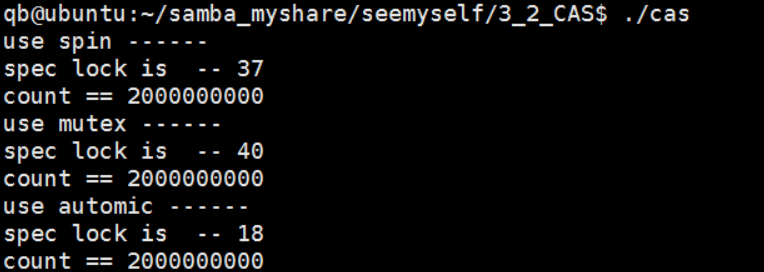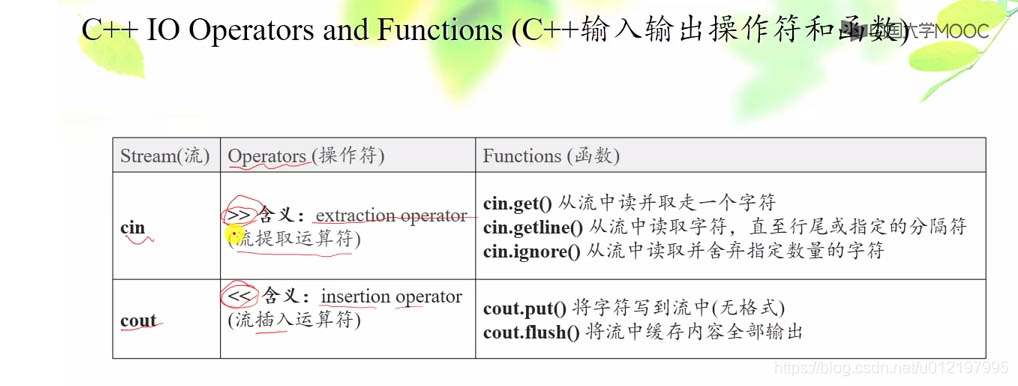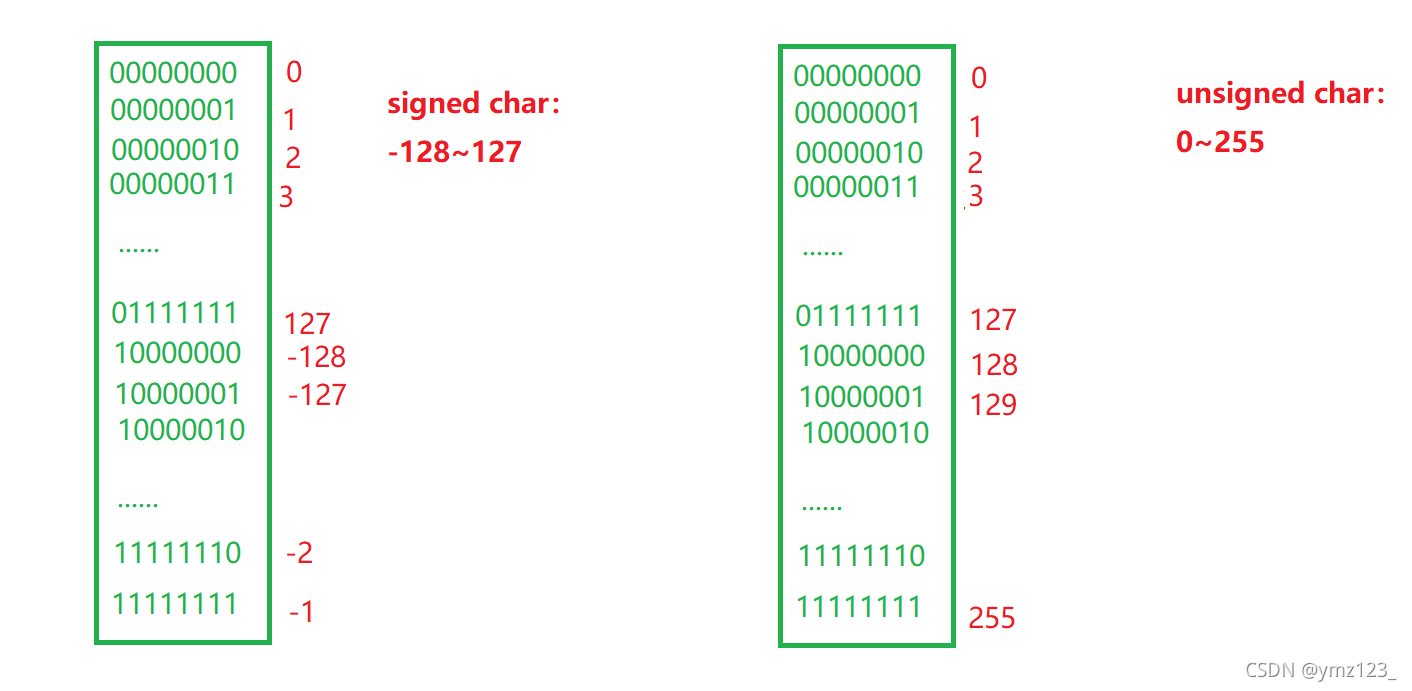互斥锁
临界区资源已经被1个线程占用,另一个线程过来访问临界资源的时候,会被CPU切换线程,不让运行后来的这个线程
适用于 锁住的内容多,(例如红黑数的增加节点操作),切换线程的代价小于等待的代价
自旋锁
临界区资源已经被1个线程占用,另一个线程过来访问临界资源的时候,相当于是一个 while(1)
不断的查看这个资源是否可用,如果可用,就进去访问临界资源,如果不可用,则继续循环访问
适用于锁住的内容少,(例如就执行++操作),切换线程的代价大于等待的代价
原子操作
执行的操作完全不可分割,要么全部成功,要么全部失败
最好的方式就是适用原子操作
实操
需求场景:
1、用10个线程分别对 count 加 100000 次, 看看结果是否是 10*100000
- main 函数中创建 10 个线程
- 线程函数中调用 inc 做数据的增加
- 分别使用 互斥锁,自旋锁,和原子操作,来进行控制
#include <stdio.h>
#include <pthread.h>
#include <unistd.h>
#define PTHREAD_NUM 10
#define INFO printf
pthread_mutex_t mutex;
pthread_spinlock_t spin;
int inc(int *v,int add)
{
int old;
//汇编,做一个原子操作
__asm__ volatile(
"lock;xaddl %2, %1;"
:"=a" (old)
:"m"(*v),"a"(add)
:"cc","memory"
);
return old;
}
void * thread_callback(void *arg)
{
int *count = (int *)arg;
int i = 100000;
while(i--)
{
#if 0
//互斥锁
pthread_mutex_lock(&mutex);
(*count)++;
pthread_mutex_unlock(&mutex);
#elif 0
//自旋锁
pthread_spin_lock(&spin);
(*count)++;
pthread_spin_unlock(&spin);
#else
//原子操作
inc(count,1);
#endif
usleep(1);
}
}
int main()
{
pthread_t thread[PTHREAD_NUM] = {0};
pthread_mutex_init(&mutex,NULL);
pthread_spin_init(&spin,0);
int count = 0;
for(int i = 0;i<PTHREAD_NUM;i++){
pthread_create(&thread[i],NULL,thread_callback,&count);
}
for(int i = 0;i<100;i++)
{
INFO("count == %d\n",count);
sleep(1);
}
return 0;
}
如上代码还是很简单的,感兴趣的 xdm 可以自行运行,控制自己使用互斥锁,自旋锁或者是原子操作看看效果进行对比一下
2、mutex、lock、atomic 性能对比
思路还是和上面的思路类型,咱们可以通过下面的代码来实际初步看看 mutex、lock、atomic 各自的性能
//并发
//互斥锁mutex
// 如果获取不到资源会让出cpu
// 使用场景
// 共享区域执行的内容较多的情况
//自旋锁spinlock
// 如果获取不到资源,会原地自旋,忙等
// 使用场景
// 共享区域执行的内容较少的情况
//原子操作
// 不可分割
// 使用场景
// 做简单++、--操作
//
#include <stdio.h>
#include <pthread.h>
#include <unistd.h>
#include <time.h>
#define MAX_PTHREAD 2
#define LOOP_LEN 1000000000
#define LOOP_ADD 10000
int count = 0;
pthread_mutex_t mutex;
pthread_spinlock_t spin;
typedef void *(*functhread)(void *arg);
void do_add(int num)
{
int sum = 0;
for(int i = 0;i<num;i++)
{
sum +=i;
}
}
int atomic_add(int *v,int add)
{
int old;
__asm__ volatile(
"lock;xaddl %2, %1;"
:"=a" (old)
:"m"(*v),"a"(add)
:"cc","memory"
);
return old;
}
void * atomicthread(void *arg)
{
for(int i = 0;i<LOOP_LEN;i++){
atomic_add(&count,1);
}
}
void * spinthread(void *arg)
{
for(int i = 0;i<LOOP_LEN;i++){
pthread_spin_lock(&spin);
count++;
//do_add(LOOP_ADD);
pthread_spin_unlock(&spin);
}
}
void * mutexthread(void *arg)
{
for(int i = 0;i<LOOP_LEN;i++){
pthread_mutex_lock(&mutex);
count++;
//do_add(LOOP_ADD);
pthread_mutex_unlock(&mutex);
}
}
int test_lock(functhread thre,void * arg)
{
clock_t start = clock();
pthread_t tid[MAX_PTHREAD] = {0};
for(int i = 0;i<MAX_PTHREAD;i++)
{
//创建线程
int ret = pthread_create(&tid[i],NULL,thre,NULL);
if(0 != ret)
{
printf("pthread create rror\n");
return -1;
}
}
for(int i = 0;i<MAX_PTHREAD;i++){
//回收线程
pthread_join(tid[i],NULL);
}
clock_t end = clock();
//printf("start -- %ld\n",start);
//printf("end -- %ld\n",end);
//printf("CLOCKS_PER_SEC -- %ld\n",CLOCKS_PER_SEC);
printf("spec lock is -- %ld\n",(end - start)/CLOCKS_PER_SEC);
}
int main()
{
pthread_mutex_init(&mutex,NULL);
pthread_spin_init(&spin,0);
//测试spin
count = 0;
printf("use spin ------ \n");
test_lock(spinthread,NULL);
printf("count == %d\n",count);
//测试mutex
count = 0;
printf("use mutex ------ \n");
test_lock(mutexthread,NULL);
printf("count == %d\n",count);
//测试atomic
count = 0;
printf("use automic ------ \n");
test_lock(atomicthread,NULL);
printf("count == %d\n",count);
return 0;
}结果

通过上述结果,我们可以看到,加互斥锁,自旋锁,原子操作,数据都能如我所愿的累加正确,在时间上面他们还是有一定的差异:
自旋锁 和 互斥锁 在此处的案例性能差不多,但是原子操作相对就快了很多
到此这篇关于C语言中互斥锁与自旋锁及原子操作使用浅析的文章就介绍到这了,更多相关C语言互斥锁内容请搜索好代码网以前的文章或继续浏览下面的相关文章希望大家以后多多支持好代码网!





